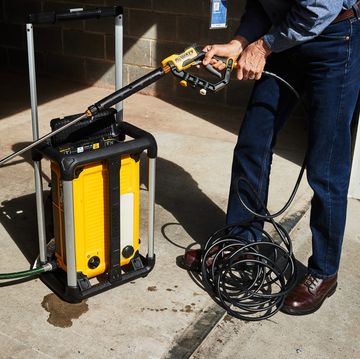An asphalt driveway is an investment that's well worth protecting. A little time spent patching and sealing can extend the life of the blacktop and improve the curb appeal—and value—of your home. There's no better time of year to restore asphalt than right now, before winter arrives with its punishing weather and subfreezing temperatures.
But before you apply a topcoat sealer, you must inspect the driveway and make the necessary repairs. Here's how.
Before You Seal the Driveway
1. Look for trouble spots
Carefully inspect every square foot of your driveway and make note of any cracks, oily stains, potholes, or areas that are crumbling. Pay particular attention to the very end and edges of the driveway, which are especially susceptible to damage.
2. Scrub away stains
If you find oil or grease stains, try removing them with hot, soapy water and a stiff-bristle scrub brush. If that fails, dissolve the stains with a degreaser such as Oil Eater or Krud Kutter.
3. Fill in cracks
Most driveways will have at least a few cracks, which must be repaired before you apply an asphalt sealer. It's important to repair all cracks, even the smallest ones. If you don't, they'll only grow wider and longer over time.
There are several different products available for filling cracks in asphalt driveways, including ones that come in pourable-liquid squeeze bottles, caulking tubes, and preformed rolls. The appropriate filler to use will depend on the size of the crack.
For example, most liquid fillers will repair cracks up to about one-quarter inch wide. For cracks between one quarter inch and one-half inch, you'll need an asphalt-repair caulk or roll-type filler. In some cases, you may need to go through two applications to fill the crack so that it's flush with the surface of the driveway. For cracks wider than one-half inch, stuff foam backer rod into the crack, then apply caulk or roll-type crack filler. Be sure to read and follow the manufacturer's instructions for best results.
Important: Before applying any filler, use a wet-or-dry vacuum to clean the cracks of loose dirt, grass, stones, or other matter. If necessary, use a slotted screwdriver, awl, or similar tool to pick out any trapped debris, grass, or weeds.
4. Patch potholes
If your driveway's cracks have widened into potholes, you're in for a different fix. Repair potholes, deep depressions, and crumbled areas with blacktop patch (also called cold patch). Blacktop patch is essentially ready-to-use asphalt that comes in a bag. (If your new bag of blacktop patch feels hard or frozen, drop it on the ground a few times and roll it back and forth to break up the material inside.)
Brush or vacuum the area clean, making sure to remove any pieces of loose asphalt or substrate. Cut open the bag and use a shovel to spread blacktop patch about 2 inches deep across the hole. Compact the area with a hand tamper, or a spare length of 4 x 4 or 2 x 4. Add more blacktop patch, if necessary, and compact the area again. Repeat this process until the hole is slightly overfilled. Then drive your car back and forth over the patch until it's flush with the driveway. If the patch sinks below the surrounding surface, add more blacktop patch and repeat. Allow the patch to cure at least 24 hours before sealing.
5. Prep the driveway for sealing
The last step before applying a sealer is to thoroughly clean the driveway. Start with a push broom and sweep away the heaviest debris. Then use a garden hose, or better yet, a pressure washer to rinse the surface clean of all loose dirt, sand, and grit. Start at the highest end of the driveway and work down and out toward the edges. If your driveway is very dirty and difficult to scrub clean, consider using a concentrated asphalt cleaner, such as Driveway Kleen.
Sealing the Driveway
Check the weather forecast before applying sealer. Depending on the sealer used, you may need two to three days of dry, sunny weather for the sealer to set and dry properly. Make sure the driveway's surface is completely dry before starting.
There are several different types of asphalt-driveway sealers available. The least expensive, tar-emulsion sealers, provide minimal protection but only cost about $12 per 5-gallon pail. However, they require constant stirring throughout application. Asphalt-emulsion sealers are the most popular type of driveway sealer. They cost about $20 to $25 per 5-gallon pail, typically don't require stirring, and provide excellent resistance to oil stains and water penetration.
Advanced latex-acrylic sealers last longer, fade less, and dry very quickly. In most cases, you can drive your car onto the driveway just 4 hours after sealing; for most other sealers you must wait 24 hours. These features come at a cost, though: $50 to $65 for 2 gallons of sealer. Lastly, there are industrial-duty liquid-rubber sealers that are fortified with titanium. They provide superior surface protection and wear-resistance, but they cost–I hope you're sitting down—more than $500 per 5-gallon pail.
Each type of sealer comes with specific application instructions, so it's crucial to use the exact tools and methods the manufacturer recommends. Most sealers are applied with a long-handled tool that has a flexible rubber squeegee on one edge and a short, stiff-bristle brush on the other. You use the squeegee blade to spread the sealer around and the bristle brush to even it out. Other sealers are applied with a thick-nap paint roller.
Again, it's important to follow the manufacturer's recommendations, but here's how sealers are typically applied: Pour a 12-inch-wide ribbon of sealant across the driveway, then push and pull the sealant with the squeegee to cover an area that's about 3 feet wide by the width of the driveway. Repeat this process, overlapping the previous section, until you've covered the entire driveway. Now immediately go back and use the bristle-brush edge to spread out any excess sealant that may have settled into low spots.
Allow the first coat to dry for 6 to 12 hours, then apply a second coat. (It's best to apply two thin coats rather than one thick coat.) Once you're done, use sawhorses or brightly colored ribbons to block the end of the driveway to traffic for at least 24 hours.
Joe is a former carpenter and cabinetmaker who writes extensively about remodeling, woodworking, and tool techniques. He has written eight books and is a contributing editor to Popular Mechanics. He also appears on the Today’s Homeowner TV show, and co-hosts the weekly Today’s Homeowner Radio Show. Joe writes from his home in Roxbury, Connecticut.













